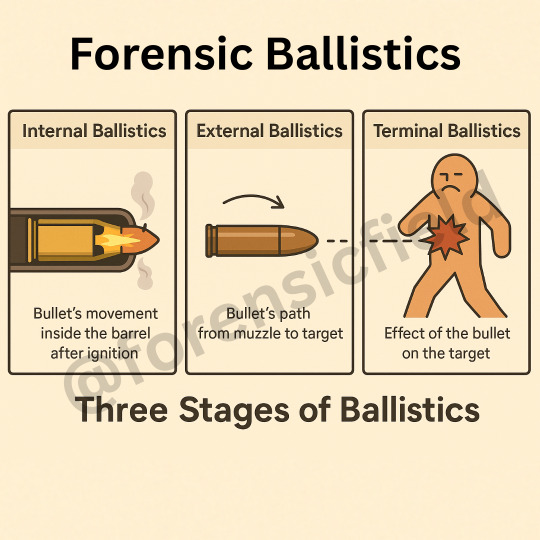#forensic science
Explore tagged Tumblr posts
Text
This post is for anyone interested in forensic science.
Forensic science is separated into what I call The three B’s Blood, Bodied and Bones. I’ll lay out the pros and cons for each option and things that will make each one easier.
Blood: easier if you like physics and math.
Pros: Learning liquid physics, easier to keep a consistent work schedule, smells the least bad
Cons: if you don’t like math it will suck, getting comments about Dexter EVERY TIME you say your job, sometime really mentally taxing.
Bodies: easier if you have an interest in medicine and surgery and if you have a strong stomach around guts
Pros: Learning some things that can apply in first aid situations, learning how to identify COD (kinda cool), medical examiner pays really well
Cons: Sometimes smells the worst, hardest on people emotionally, requires really steady hands, usually less consistent work schedule.
Bones: easier if you are comfortable with various temperatures, like puzzles, have a strong gut for rotting stuff and are fine with bugs
Pros: least emotionally taxing, you aren’t working for law enforcement, you get to travel, you get to solve puzzles, you get to discover historical sites with skeletons.
Cons: sometimes the body isn’t fully decomposed and it stinks, a LOT of bugs, never home, grave robbing jokes.
They are all good options it’s just depends on what you like
#forensic science#forensic science nerd#forensics#forensic analysis#forensic anthropology#blood splatter#medical examiner#csi#body analyst
95 notes
·
View notes
Text
The forensic analysis for the Bibas children has been completed and according to news outlets Yarden himself wants people to know how they died.
Now, if you're not someone who can handle this type of stuff I strongly suggest you do not read further. Edit: The Bibas family has asked that the details of Shiri and the boys' deaths not be discussed. They want the world to know they have been murdered, but not in extreme detail. While Hagari has stated that Yarden told him to tell the world, it is likely that Yarden and the rest of the family did not understand what that entailed. I've run into this problem when having to do press releases myself where we go into what we believe is a proper amount of detail regarding a victim(s)'s murder, what was done, and what the public should know. This is not always in line with the family's intent and that can change after the information is already out there.
For their sake I am reducing the amount of detail in this post and removing the article. However, the information is already out there and if you so desire you can find articles about it on many news sites.
They were killed and then mutilated post mortem in an attempt to cover up what had been done. The mutilation was done to simulate a building collapse to try and falsify that they'd be killed in an airstrike.
This is what forensic science does. It can determine peri and post mortem injuries and provide us a timeline of what likely occurred due to the evidence, rather than listening to the terrorists who have lied repeatedly.
Post mortem mutilation typically falls into three general categories; One is done to obfuscate forensics and hide what was done to the victim(s). Another is done in crime of passion scenarios where the perpetrator is not completely unaware of what they are doing and simply go above and beyond the act of killing. And the third is done to cause psychological distress to the victim(s), victim families, and community.
Regardless, it is one of the few things that will get you the death penalty here in the USA and I have been part of a number of cases where the accused will vehemently deny the mutilation and openly confess to the killing because it is such a heinous thing to do. Forensic pathology can determine what wounds were caused peri and post mortem, and determine how much time likely passed in the interim.
This means that even if the crime itself was one of passion there can be a cool down period before post mortem mutilation occurs. Meaning that regardless of emotional highs during the initial crime, the secondary act was done with one of the other two intentions. For all we know it could likely be that it was done to obfuscate and cause psychological distress.
Consider that Hamas has previously stated that the Bibas children were killed in Israeli airstrikes, I don't think either intention is out of the picture. Furthermore, there are a number of "anti-Zionist" accounts on here that range from neo-Bundists, to tankies, to Jew fakers who repeated the Hamas lie that Israel killed the children during an airstrike. They are going to goalpost, and actually are right now as I am typing this, that Israel is now lying about the forensic science.
Repeatedly these accounts and persons have had to goalpost and mental gymnastic their positions in order to maintain that Israel and (((Zionists))) are the worst thing ever and Hamas and its affiliates are just innocent freedom fighters.
This is conspiracy thinking. We saw this with Sandy Hook Truthers and, I guess, you can label these accounts/persons as Bibas Family Truthers. Another person on jumblr said we were going to see this behavior and it hasn't even been 24 hours before the usual suspects started.
And I give credit where credit is due to Israel because they knew this type of conspiracy thinking would come out about their forensics, so they've shared their results and evidence with international labs. While it may be some time before it gets further verified, we will likely see these same accounts move the goalpost again to try and blame Israel for the death of the Bibas children, take the onus of responsibility off of Hamas and affiliates, and accuse Zionists of being Nazis once again. And remember, if you're doing any one of these things (or a combination of them) then you're not a good person.
You're an antisemitic bigot (even if you're one of us, and especially if you're pretending to be).
#jumblr#antisemitism#leftist antisemitism#intersectional antisemitism#Bibas Family#Israel#Forensic science#A forensic scientist speaks#Faux activism
460 notes
·
View notes
Text

Nicolae Minovici is known as the doctor who hanged himself for science.
He had studied at the Faculty of Medicine and Bucharest where he developed a keen interest in forensic medicine and criminology. He was particularly fascinated in the changes in the body during violent deaths, especially hanging which was a common form of execution at the time.
After his graduation, he founded the first Institute of Legal Medicine in Bucharest and his work laid the foundation for modern forensic practices in Romania and influenced the development of criminology and forensic pathology in Europe.
Among his contributions to science was his experiments in hangings. In an effort to understand the physical and physiological effects of hanging, Minovici decided to conduct experiments on himself. Beginning in 1904, he hanged himself multiple times under controlled conditions. To avoid death, he used a system of ropes and pulleys that allowed him to control the pressure exerted on his neck.
The results of Minovici's self-experiments were groundbreaking. He described the sensations he experienced during hanging, including a tightening sensation in the throat, severe headaches, vision changes, and an overwhelming feeling of impending death. He also observed that the face quickly became congested and discolored due to the interruption of blood flow, a condition known as facial cyanosis.
Minovici's work contributed valuable insights into the mechanics of hanging and its effects on the body. His findings were published in a monograph titled Studies on Hanging, which became an important reference for forensic scientists and criminologists. His research helped to better understand the processes of asphyxiation and the physical signs of hanging, which were crucial for accurate post-mortem examinations in cases of suspected hanging.
390 notes
·
View notes
Text
forensic scientist evan keeps a part of every victim. a hand, a skull, a leg... he's got an entire room for human remains full of shelves and a big examination table in the middle. there's also a pinboard with pictures of decomposed bodies and murder victims on the wall.
#he's me i fear#☆ mad scientist ☆#the marauders fandom#the marauders#the marauders era#the slytherin skittles#slytherin skittles#evan rosier#evan rosier blog#evan rosier hc#forensic scientist#forensic science#forensics
85 notes
·
View notes
Text
An Undergraduate Forensic Viewing of Like Minds (2006) Train Scene

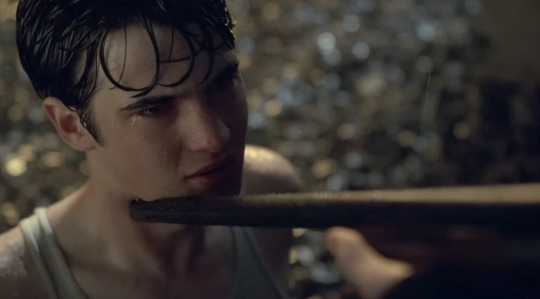
Pray for me. Pray for yourself. We are one now.
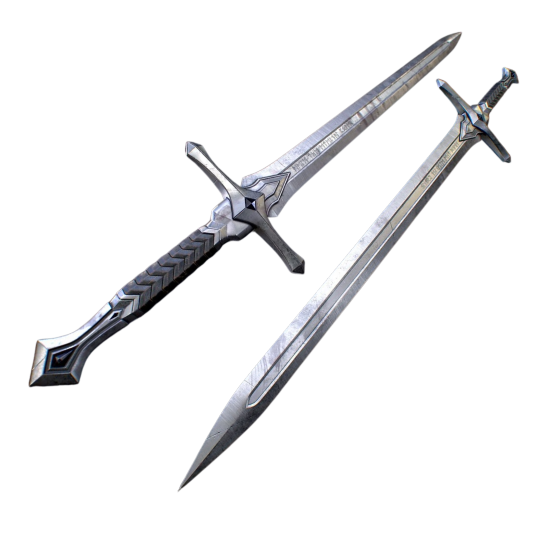
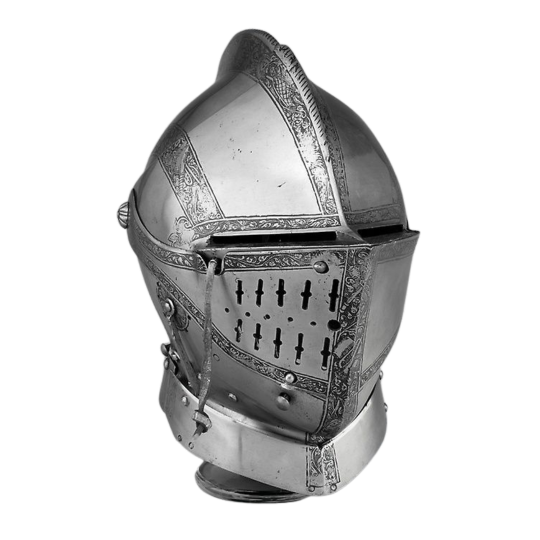
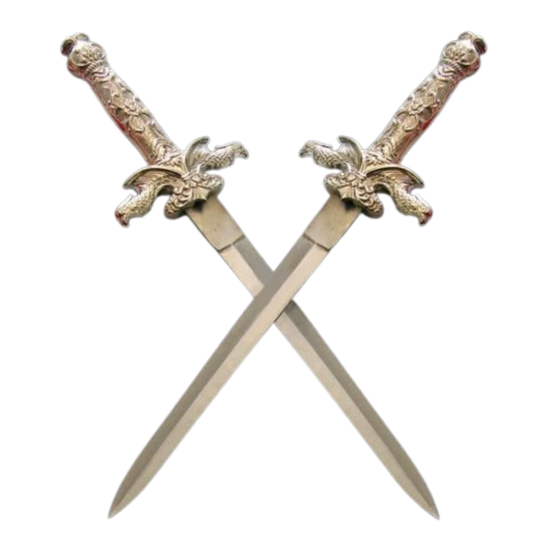
Contents:
1. Introduction 2. What We Know 3. The Investigation 4. Bibliography for Nerds

1. Introduction
Some justifications first.
I'm an undergraduate stem student obssessed with many topics, including forensic studies. I just finished a complete course about forensic chemistry/tecnology/law in uni and yes, I'm a big failure of a person and was thinking about applying some of the things I've learned into Like Minds' train scene. To clarify, I'm not an experienced profissional of the field. It is to say, I've never worked in such area and had just one or two significant interaction with said profissionals and students. My considerations won't be 100% accurate, clearly, and I may mistake or ignore fundamental data and studies. I intend solely to present some interesting facts and rapidly discuss their applicability here.
Take everything I say with large grains of salt, this is mostly for my enjoyment.
Let's kill Nigel!
2. What We Know
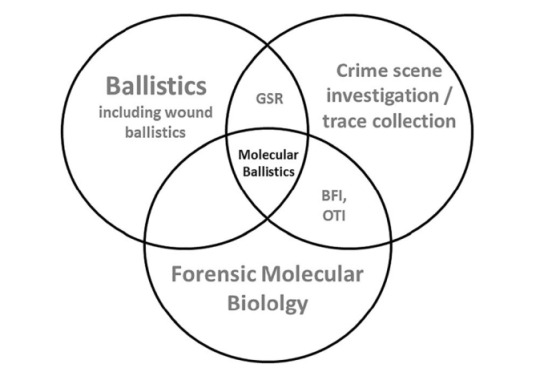
Figure 1. Visual diagram of forensic ballistics' main areas of study. Some will be mentioned here. [1]
2.1. Ballistics - Anatomy of a Discharge
Ballistics is a science field divided in three main ramifications: (1) Interior Ballistics, (2) Exterior Ballistics and (3) Terminal Ballistics. (1) studies the mechanism of a gun discharge, (2) studies the trajectory and behavior of a projectile once it is ejected from a firegun and (3) studies the damage and overall interaction of the projectile with a material structure (biological or not). [1] Ballistics experts (chemists, some engineers, law experts, etc) ocuppy themselves with many things regarding firearms, a field of work that recuries much study and understading of multiple fields of knowledge such as spectroscopy, law and general legislation, physical properties of chemical coumponds, solid state science, material science, industry production series and others. Some areas of chemistry and biology are of great importance and are commonly used complementarily.
We then understand what bullets are. The component that effectivally hits the target in these scenarios is the actual "projectile".
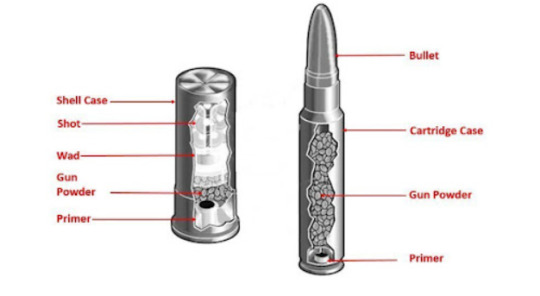
Figure 2. Simple structure of shotgun (left) and rifle (right) ammunition. [2]
In simple terms, they're composed by (1) a shell that holds everything together, (2) some coumpond responsable for the liberation of gas via chemical reaction and (3) some way to give the heat needed for said reaction to occur. There is a whole field of study and production of these killing objects that seeks out to balance some of their properties in different scenarios by the armamentist industry in oder to supply endless applications that constantly develops new shapes and components, so going through it all would be impossible. Regardless, all ammunition is classified by size, called "gauge" in shotguns, and "caliber" in rifles and handguns. [2]
Case: [in shotguns] It is a small cilindrical piece made out of a tube of common plastic or sturdy paper (the red/blue/colored part) that holds the multiple projectiles to be fired (shots), with a metallic base (the primer) composed of brass (copper and zinc) or steel (iron and carbon). [in rifles] The case is called cartridge case, and it is composed by brass as well. [2]
Powder (or propellant): They are usually Nitroclelullose (handguns), Nitroclelullose/Nitrogliceryn (rifles) and Nitroclelullose/Nitrogliceryn/Nitroguanidyn (long range rifles) [3]. Oversimplifying, organic molecules containing nitro groups (present in Nitroclelullose, Nitrogliceryn and Nitroguanidyn) are really unstable; these chemical groupaments are highly reactive in face of many scenarios. If enough energy is provided (by heating, or mechanical contact and pertubation) they will enter a decompostion process, breaking and reacting with their own bonds spontaneously, liberating gases such as H2O, N2 and CO2. These mentioned gases are much more stable compared to the original organic coumponds, so the atoms will "prefer" to form these species if the conditions are set (thus, a spontaneous reaction). This increases pressure inside the shell and forces the projectile to leave violently as a result of gas expansion. [4] Shotgun powder is composed by potassium nitrate, charcoal and sulfur; a mixture known as "dark powder", and it is separated from the shot (projectiles; multiple balls of steel, lead, rubber, or really anything) by a small component called "wad". The same principle explained in the decomposition of organic nitro-compounds apply for the potassium nitrate present here, but only in the presence of sulfur (easier to melt and ignite), providing the necessary heat for potassium citrate to generate the oxygen needed, resulting in charchoal's combustion. [2]
Primer: Primers are a fundamental part of any ammunition, and yet a simple one. When a firing pin from the firegun hits them, sparkles and heat will be produced, which gives the propellent all requiered energy for the chemical reaction. It is, when the action lever is pulled, the firing pin is tensioned by a spring inside the gun. When the trigger is pulled, this firing pin hits rapidly the ammunition's primer (metallic base). [5]
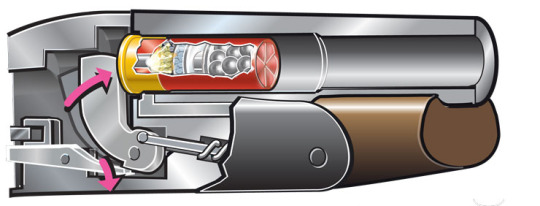
Figure 3. Shotgun firing pin scheme. [5]
The discussion of differents powders/propellents (like smokeless powder), projectiles shapes (in rifle cases) and firegun types (other than rifle and shotgun) is being ignored.
All that must be known is: the trigger pulling promotes a mechanical impact against the ammunition base, which promotes chemical reactions that liberate great amounts of gases, increasing the pressure inside the case, what will pushes the projectile(s) inside foward with great speed.
2.2. The Shotgun - Means to An End
We now restrain ourselfs to the firegun. Let us take a look on the following images:
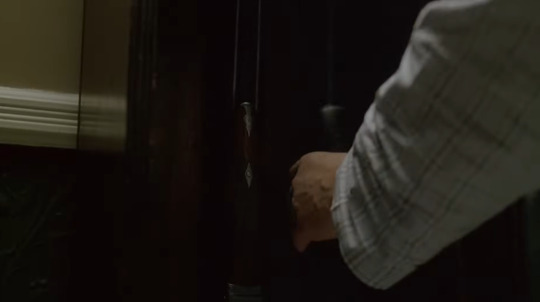
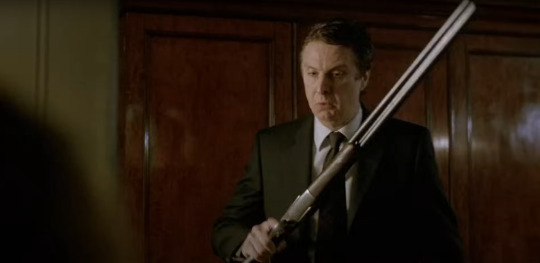
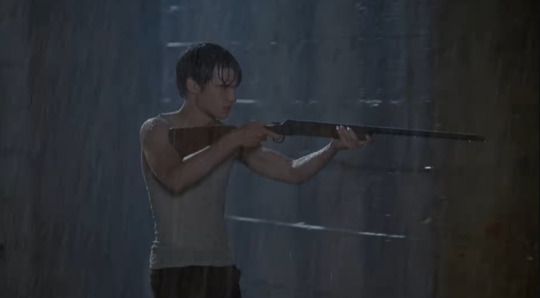
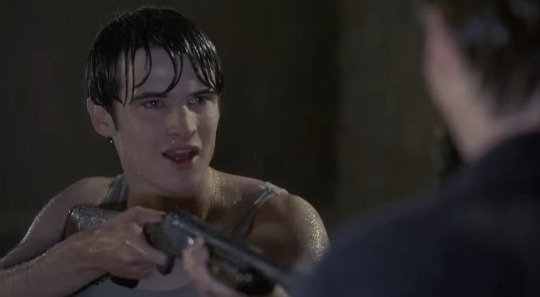
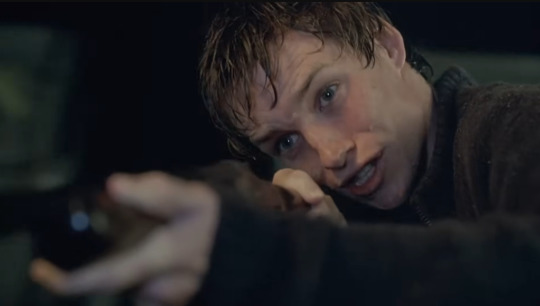
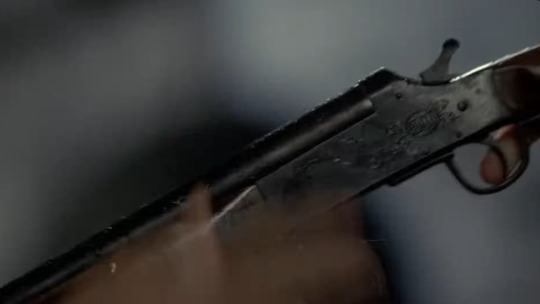
Figures 4-9 (left to right, top to bottom). Shotguns' takes from Like Minds (2006).
Main considerations:
The shotgun used by Mr. Colbie isn't the same one used by Nigel/Alex in the train scene. We can clearly point that by the number of barrels, i.e., two barrels contaning two projectiles (killing Nigel's mother and father without visible activation) in its first appearance, and only a single one in its second appearance. Maybe this has been discussed before.
It is not a narrative problem if we have the eyes for it. Nigel's father possesses two shotguns, so we assume Nigel went back and grabbed the single-barrel one before going after Alex.
The reloading thing would be important during the bedroom scene, between the moments where John shoots his wife and Alex picks up the gun from the floor. There would be no way of aciddentially shooting Mr. Colbie wihout Alex pulling the action on the second barrel (how would he know which one of the barrels were loaded and why Mr. Colbie would only activate one of the two barrels? It appears he wasn't using the shotgun to merely scare his family). Perhaps the double barrel shotgun used has some individual firing feature, perhaps.
Also, the single barrel shotgun is the same one used by John when Alex and Nigel first accessed the hidden baseament together. This isn't of great relevance though.
After a compulsive research in gun sale sites and over 900 models of shotguns (no joking), I'm inclined to believe that Nigel's single barrel shotgun is an Era 410 GA Single Shot Break Action. My conclusions is based on Figures 6 and 9, the shotgun's best takes throughout the entire movie. The important details are: a single barrel, with rounded trigger guard that ends exactly where the wooden stock begins, by a rounded break action lever with squarish shape that leans horizontally to the receiver and a rectangular like forestock. Other smaller details are: the receiver's top shape and really curved back, the declination present on the stock and the three screws' position and size.
The engraved symbols on Colbie's receiver are sculpted by a profssional artist called "engraver", by client's demand. Therefore, these sigils are decorative and probably carry some meaning to the shotgun's real owner, so they aren't a discrepancy to worry about. The frame I acquired (Figure 9) is of poor quality and there's nothing I can read in there besides one or two letters. I've tried to watch the movie in other internet sites but it didn't help that much.
It took me forever, but here it is [6], [7]. There are also youtube videos revewing this gun in the Extra section.
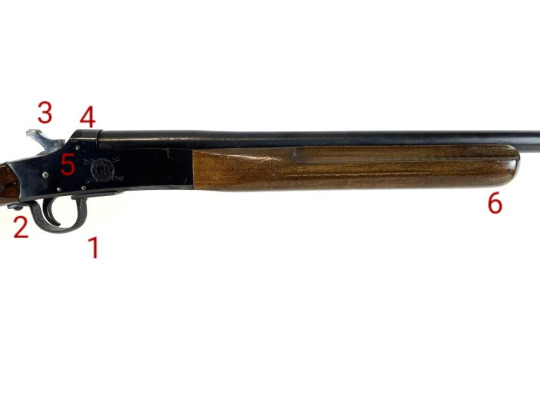
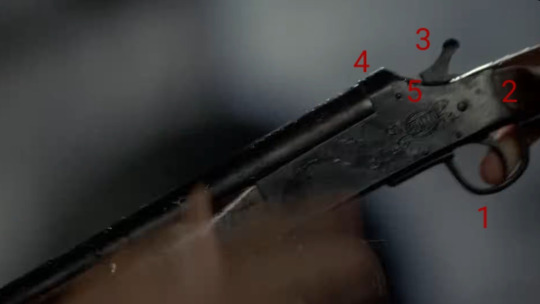
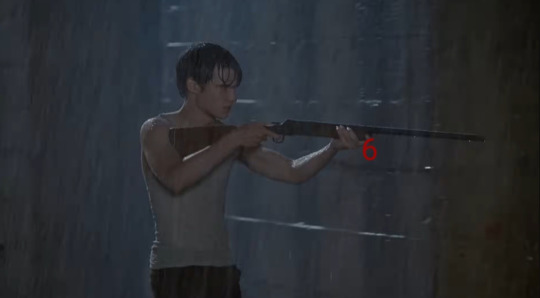

Figures 10-13. Era 410 GA Single Shot Break Action Shotgun. [6]
Note: @laurelwen successfully identified Nigel's firegun as a Boito .410. The text engraved on the shotgun's receiver in Figure 9, in fact, reads "Boito". Check it out on this post. Look up Extra Bibliography No. 7 in the shotgun's section as well.
Shotguns are a really old type of gun from the 16th century. Their mechanisms were adjusted during following centuries, but they remain still to date with an extremely simple way of function. Today, there are many types, including the single-shots and hand shotguns, much different than what was originally conceived. A break shotgun is capable of "breaking in half" for reloading, exposing its ejector/extractor and barrel interior just as many other fireguns. [8]
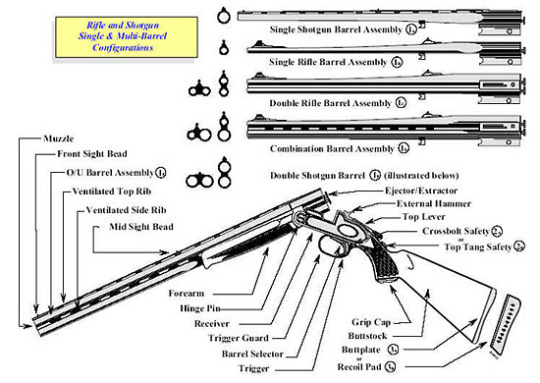
Figure 14. Break action shotgun anatomy. [9]
The Era 410 GA possesses a specially long length of barrel, which helps projectiles to achieve maximum velocity before leaving. Still, it appears from my research that this is a second hand model with low price, low demand and little historical relevance. This is the type of gun that would be bought mainly by collectors and enthusiasts; however, because of its little weight, good shooting and minimalist elegance, this firegun is not one of the worst models out there for small amateur animal hunting.
A 410 (10.41 mm, one smallest shot diameter in the market) with great pattern of dispersion after the discharge isn't bad, so at medium distances most projectiles would succesfully hit the center of a target. This is not very good when we're talking about a point-blank discharge directly at Nigel's face.
3. The Investigation
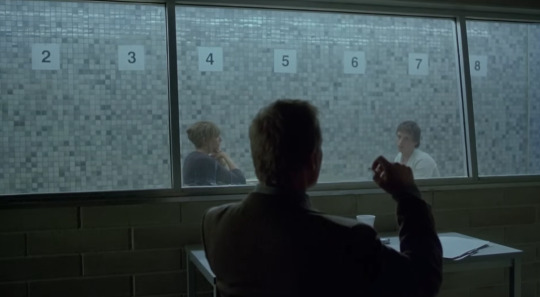
Figure 15. "If they had any evidence, I wouldn't be talking to you, would I?"
Authorities arrive at the dark, umid and isolated train tracks. Immediatly, a shocking scene: a desperate young man holding in his arms the corpse of a dead boy, disfigured. They transport the living witness away from the scene, but the lying unknown and deformed body is extracted for further autopsy. Detective McKenzie takes over with Forensic Psychiatrist Sally to interrogate the surviving suspect, Alex Forbes.
After the initial approach and first hours of interaction, the case takes an unexpected form. The question now is, did Alex Forbes shoot the now identified Nigel Colbie alone, or did Colbie participated in his own killing to incriminate Alex?
The police wastes its time thinking about common scenarios described in the book. They know the victim, the place where it happened, the exact gun used and the main suspect. Everything comes down to answering the presented question. Psycological attempts of extracting an answer from Alex by closed sessions with Sally, it is, to try and build a thrust and comfort relation with the suspect in order to obtain a confession would be protocol. But Alex clearly is beyond that, and if we must say, he's in control the whole time.
All that is left for the police is to attach towards factual evidences. Now, we describe two fundamental forensic elements of a gun-related crime.
Gunshot Residues (GSRs)
GSRs are one of the strongest evidences when it comes to forensic studies. Being composed of burnt and unburnt organic or inorganic particles from the explosive primer from the shell, propellant and possibly fragments of the bullet, cartridge case, and even the firearm, they frequently contain elements such as Sb (antimony), Ba (barium), Pb (lead) or Zn (zinc), Cu (cooper), and Ti (titanium). Their deposition concentrates away from the firearm into the shooter's (arms, face, hands and chest mainly) and victim's (region of contact mainly) bodies. GSRs can be found in nearby surfaces as well, such as the floor, ceiling, walls, objects, clothes, etc. The direct deposition of these residues must be carefully used as evidence because of its irregular distribution on the surrounding enviroment after the discharge. Thus, the main factors are always the chemical composition and concentration spots. Shotgun shots (the small spherical projectiles) are usually made up of lead or lead/antimony, but some ammunitions use steel, zinc-plated steel, tungsten and bismut in substitution (So, in our case, we can expect more significant ammounts of antimony/lead or zinc, iron and carbon). [10], [11]
A 410 ammunition is classified as "birdshots" ammunition, used for hunting said animals. The little diameter of projectiles allows the carrying of multiple projectiles inside one shell, facilitating the execution of small moving targets. The potential damage mustn't be underrated, though.
The aforementioned substances/elements can be detected, investigated, and quantified using microscopy, chemical analytical and chemometric methods, such as Scanning Electron Microscopy (SEM), Energy Dispersive X-Ray Spectroscopy (EDS), Atomic Absorption Spectroscopy (AAS) and Energy Dispersive X-Ray Fluorescence (EDXRF). All these techniques are extensively known and applied in uncountable areas of science for identification and characterization of solid materials. In a nutshell, these methods revolve around the interaction of matter with radiation (such as X-Rays) and the energy absorved/emitted by it after the interaction. The SEM is a most usefull analysis for it can provide real images of micro structures and particles present above any surface, like clothings, skin, fifregun metal and others, if properly prepared. [10]
It is important to understand that these identification methods are of extreme precision and sensibility, it is, minimal concentrations can and will be detected inneviatbly.
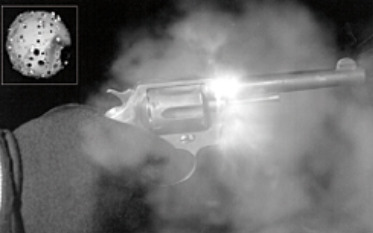
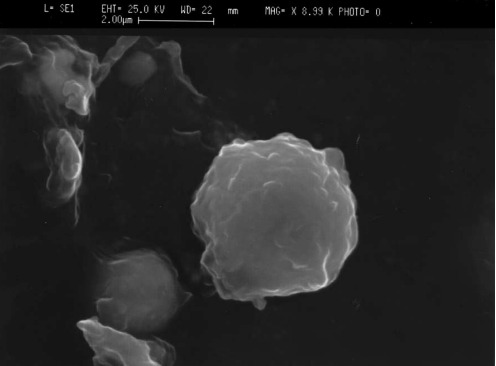
Figure 16 and 17. (Left) Image of gunshot powder residues dispersed in the air after discharge. Top left and (Right) images refer to SEM "photos" of extremely small particles of GSRs that can be chemically analyzed. [12], [13]
What about the lifespan of these residues? In long terms, the shooter's trigger hand (right hand) seems to contain most of the residues that persist for a fair amount of time after the discharge. [10] Unffortunately, the mentioned study occured in controlled enviroments, which is not the case. Another work [14] concludes that most GSRs are lost after two-four hours from the discharge. Considering the fast action from authorities described in the movie, we can basically ignore this factor and consider other variables.
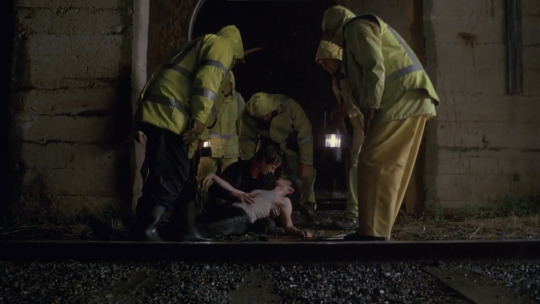
Figure 18. "All I can tell you, was that the heavens were falling. And the sound... it was incredible. It was like the Gods were rejoicing for what was done."
Backspatter Material (BM)

Figure 19. Distribution of Forward Spatter and Backspatter caused by a shot at a biological target. [1]
We hereby exclude the forward spatter, it is, the biological material projected fowards with the projectile (to the back of Nigel's head), for its little relevance, since we're not questioning the type of gun or ammunition used; we assume that Alex is describing a resonable scenario that matches with the actual damage done to Nigel. There are no consistent reasons to question this since everythings seems to support Alex's description of this.
BM comes from the combined forces of several interacting wound and ballistics effects. The collapse of the wound cavity and balance of resulting overpressure, the stream of liquid and tissue particles accelerated along the lateral surface of the projectile, the shot's contact and ejection of muzzle gases out of the entry wound from the powder cavity... Every surrouding surface must be investigated, that is, even the shotgun barrel's interior. This small ambience is fairly protected from external pertubations and houses BM from the shot. Considering the poximity with Nigel's face, we can almost assure to encounter biological material with DNA inside. The bellow mentioned study cites another work where a 9 mm pistol cointaned backspatter material from test targets even at a distance larger than 1 meter, much greater then the few inches that separated Nigel's face from the barrel. [1]
Matter of fact, this biological material can pass by processes of Organ Tissue Identification (OTI) and Body Fluid Identification (BFI) if Nigel's identity was at question, or if we desire to understand more profundly the projectile's damage caused to his skull/face/tissue. [1]
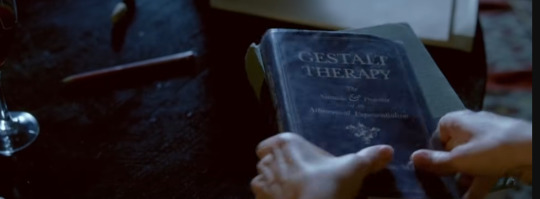
Figure 20. "None of what I've heard makes him a murderer."
So, how can we gather this up to develop the investigation? Utilizing only these two fundamental concepts, we can make a few assumptions.
The big question here is if whether or not Nigel's hands were present by Alex's when the trigger was pulled, which would lead the police to support or oppose Alex's narrative. Chemical examination with organic solvents (which won't cause preocupant harm to a dead body) and analytical methods could immediatly point to the presence of GSRs or biological/non biological BM. If Nigel's hands were elevated in his head level (or superior) in the instant of discharge, trace amounts of discussed metals/elements coming from the firing mechanism and ammunition, as weel as little to some biological material, would definetly be found in his hands and forearm skin since there was no clothing covering. Any substance found in his hands/forearm could be microanalytical compared to the ones present in Alex's hands, clothes and face as well. This could be done with really small samples of fresh skin. On the other hand, if Nigel's arms were lowered at the instant of discharge, we could still expect the presence of GSRs in his arms (yet, in less amounts) but the abssence of backspatter materials most certantly. This would classify Alex as a murderer without excuses, even if he alleged that Nigel asked for it.
In the scenario where Alex discharges at Nigel from a great distance (configuring simply murder) we could note the abssence of GSRs in every part of Nigel's body except for the targeted region (perhaps if they were at a greater distance to each other) and the presence of these GSRs in Alex, but in much higher concentration.
But the enviromnent's conditions are of primordial importance. Nigel and Alex stand in an open area, with considerable wind, heavy rain and gravel soil. The heavy rain could simply carry way much of these residues from Alex's body, clothes and Nigel's hands as well. Most GSR would probably be lost to those conditions and its deposite upon the soil's surface would be extremely hard to be quantitatively analized due to unknown degrees (elevated) of impurities and diverse materials and dirt present, but qualitative tests would still be valid.

The knowledge about the victim, crime scene, shooter, exact firegun and time of the tragic event allied with the fast action from authorities saves most of the police's efforts on identifiying and tracking down evidences. However, what remains still offers a challenge. The best evidence here, GSRs left by the discharge, would be of questionable help considering the presence of heavy rain in sight. Still, analitical quantities of them, if detected in Nigel's skin by proper chemical and espectroscopy-related analysis, can be used to comparate probable ammounts present in Alex's clothing and skin (despite the difficult of such). With that being said, the police would find themselves in a much more complex case of muder/assisted suicide, and further evidences and information about their relationship and recent whereabouts would ineviatably need to be extracted from external sources (such as parents, school's employess, close friends and students). Despite all this, Alex's final acting of removing Susan's body and disapearing from sight (not to mention the card left in Sally's car) immediatly sustent his guilt in a case where he already was the main suspect and basically confirmed criminal. And you know, breaking into a cemetery and extracting a corpse from its grave is definetly worth of some jail time. The Colbie's House Murder would certainly incriminate Alex for homicide as well, and the current Brotherhood's little political influence wouldn't prevent him from this destiny, as it appears. But the case is not over.
Further evidences were to be discussed, if it was not for the dissapearing of Alex Forbes.
The subject now roams unknowingly through England with mysterious intents. Its participation on the described case still lacks formal arguments and the Court should now approve his arrest warrant and search decree. Alex Forbes will most probably live to perpetrate the deluded fantasy responsable for the death of three young students in order to carry the sacred holy burden of an ancient templar bloodline.
Yet, we pray.


Who's the enemy now? We are.
4. Bibliography
[1] Euteneuer J, Courts C. Ten years of molecular ballistics-a review and a field guide. Int J Legal Med. 2021 Jul;135(4):1121-1136. doi: 10.1007/s00414-021-02523-0. Epub 2021 Feb 16. PMID: 33594457; PMCID: PMC8205864. [2] https://spotterup.com/how-ammo-works/ [3] Serol, M.; Ahmad, S.M.; Quintas, A.; Família, C. Chemical Analysis of Gunpowder and Gunshot Residues. Molecules 2023, 28, 5550. https://doi.org/10.3390/molecules28145550 [4] Guanchao Lan, Jing Li, Guangyuan Zhang, Jian Ruan, Zhiyan Lu, Shaohua Jin, Duanlin Cao, Jianlong Wang, Thermal decomposition mechanism study of 3-nitro-1,2,4-triazol-5-one (NTO): Combined TG-FTIR-MS techniques and ReaxFF reactive molecular dynamics simulations, Fuel, Volume 295, 2021, 120655, ISSN 0016-2361, https://doi.org/10.1016/j.fuel.2021.120655. [5] https://www.hunter-ed.com/national/studyGuide/How-the-Shotgun-Shoots/201099_92815/ [6] https://www.invaluable.com/auction-lot/era-410-ga-single-shot-break-action-shotgun-131-c-8284a72a5b [7] https://firearmland.com/item/1079096107 [8] https://www.letsgoshooting.org/resources/articles/shotgun/meet-the-shotgun/ [9] https://www.atf.gov/firearms/firearms-guides-importation-verification-firearms-ammunition-and-implements-war-top-break [10] Virginie Redouté Minzière, Céline Weyermann, Organic and inorganic gunshot residues on the hands, forearms, face, and nostrils of shooters 30 min after a discharge. Science & Justice, Volume 64, Issue 5, 2024, Pages 557-571, ISSN 1355-0306, https://doi.org/10.1016/j.scijus.2024.08.002. [11] Joshua Hallett, Michael Stolk, Michael Cook, K. Paul Kirkbride, Examination of gunshot residue arising from shotgun cartridges containing steel, bismuth or tungsten pellets. Forensic Science International, Volume 306, 2020, 110096, ISSN 0379-0738, https://doi.org/10.1016/j.forsciint.2019.110096. [12] https://www.bka.de/EN/OurTasks/SupportOfInvestigationAndPrevention/ForensicScience/PhysicalEvidence/Homicide/GunshotResidue/gunshotresidue_node.html [13] Francesco Saverio Romolo, Pierre Margot, Identification of gunshot residue: a critical review. Forensic Science International, Volume 119, Issue 2, 2001, Pages 195-211, ISSN 0379-0738, https://doi.org/10.1016/S0379-0738(00)00428-X. [14] Jalanti, T & Henchoz, P & Gallusser, Alain & Bonfanti, M.S.. (1999). The persistence of gunshot residue on shooters’ hands. Science & justice : journal of the Forensic Science Society. 39. 48-52. 10.1016/S1355-0306(99)72014-9.
Extra
random materials, take a look
1. Chemistry of Explosives (book pdf) https://link.springer.com/chapter/10.1007/978-1-4612-0589-0_5 2. ERA 410 GA video 1 https://www.youtube.com/watch?v=lGWm2aaWVAc&ab_channel=SteadFastCourage 3. ERA 410 GA video 2 https://www.youtube.com/watch?v=2S16C5Y6lxY&ab_channel=esquad540 4. Quick discussion about Smokeless Powder on r/guns https://www.reddit.com/r/guns/comments/1tawwm/things_i_want_you_to_know_about_smokeless_powder/#:~:text=Because%20of%20something%20called%20oxygen,and%20temperatures%2C%20leading%20to%20fouling. 5. A little on the kinetic energy of specific projectiles (everything applies here as well) https://nodoroc.com/d/node/20 6. A little more on ammunition Caliber https://www.globalsecurity.org/military/systems/munitions/bullets2-types.htm#google_vignette
For the sake of archieving, here are some shotguns I've separated to double check during my research until the Era 410 GA appeared. Curious enough, number 7, called "boito", appears to be another common name given to Era 410. Woops.
1. https://www.bidsquare.com/online-auctions/north-american-auction/victor-break-action-single-shot-12-ga-shotgun-4988316 2. https://www.crescentcityauctiongallery.com/auction-lot/stevens-arms-.410-gauge-single-shot-break-open-sh_9F84899825 3. https://palmettostatearmory.com/jts-shotguns-single-shot-410-bore-26-single-shot2.html 4. https://en.wikipedia.org/wiki/File:Stoeger-Coach-Gun.jpg 5. https://www.gunsinternational.com/guns-for-sale-online/shotguns/harrington-richardson-shotguns/h-r-bay-state-20-ga.cfm?gun_id=103017190 6. https://www.bankstowngunshop.com.au/product/12g-unknown-model-unknown-single-barrel-blued-wood-28-barrel-poor-condition/ 7. https://www.bankstowngunshop.com.au/product/410-boito-model-reuna-28-single-barrel-blued-timber-3-chamber-sec9622/ 8. https://www.bankstowngunshop.com.au/product/12g-harrington-richardson-model-1908-single-32-barrel-blued-wood/ 9. https://www.bankstowngunshop.com.au/product/12g-norinco-model-std-single-barrel-30-shotgun-great-condition/
10. https://www.bankstowngunshop.com.au/product/12g-raick-freres-model-unknown-single-barrel-30-shotgun-belgium/ 11. https://gritrsports.com/henry-repeating-arms-single-shot-12ga-shotgun-h015-12 12. https://www.tmguns.co.uk/store/p1418/Tomas_Agote%2C_Eibar_12G_single_hammer_ejector_shotgun.html 13. https://www.tmguns.co.uk/store/p1659/Vanguard_Game%2FVermin_.410_hammer_ejector_single_barrel.html 14. https://www.tmguns.co.uk/store/p1290/Astra_Ciclope_12G_single_barrel_hammergun.html 15. https://www.tmguns.co.uk/store/p1883/Rossi_Game%2FVermin_20G_single_hammer_ejector_shotgun.html 16. https://en.wikipedia.org/wiki/File:Stevens_511_Shotgun.jpg 17. https://www.gunsinternational.com/guns-for-sale-online/shotguns/harrington-richardson-shotguns/harrington-richardson-44-smoothbore.cfm?gun_id=102901609
thank you for reading

#like minds#murderous intent#nigel colbie x alex forbes#nigel colbie#alex forbes#forensic science#analysis#Spotify
44 notes
·
View notes
Text
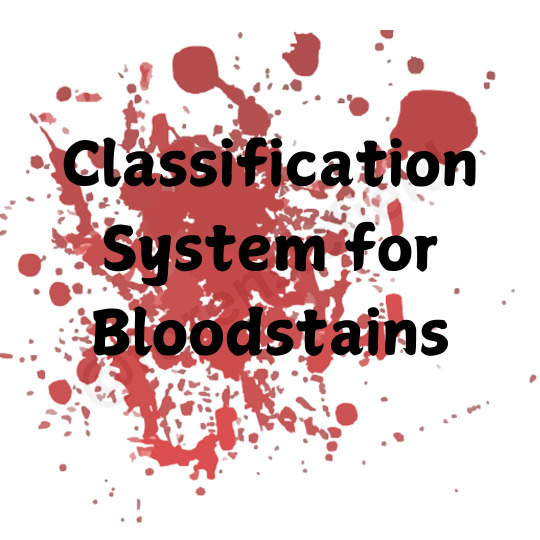
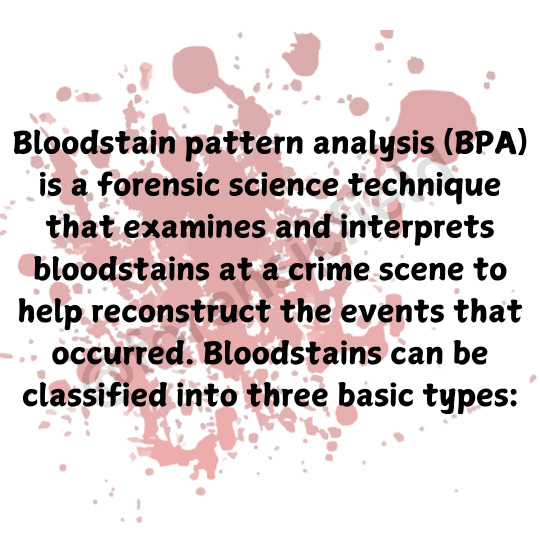

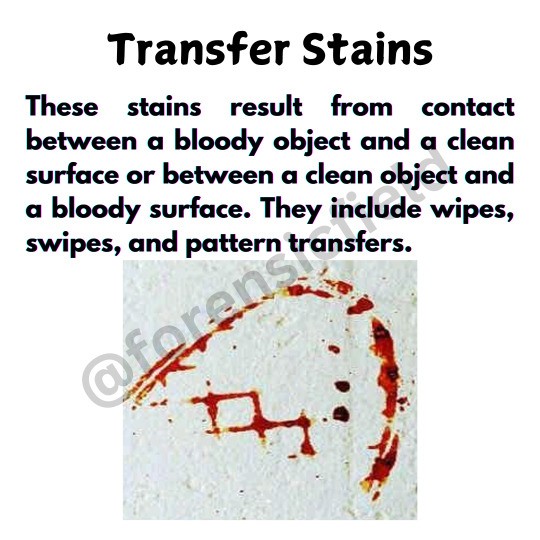

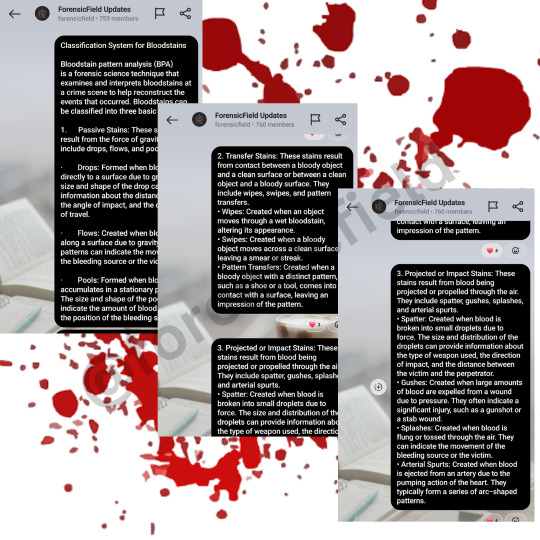
#forensics#criminology#forensic science#evidence#criminalistic#forensic field#crime#forensic#crime scene investigation#blood stain
112 notes
·
View notes
Text
To everyone who asked what the high school math they were learning was good for, the Pythagorean theorem is actually used in forensic science to find the point of origin of blood splatter 😊
#forensic science#silence of the lambs#hannibal lecter#the silence of the lambs#shitpost#hannibal#mathblr#science side of tumblr
74 notes
·
View notes
Text
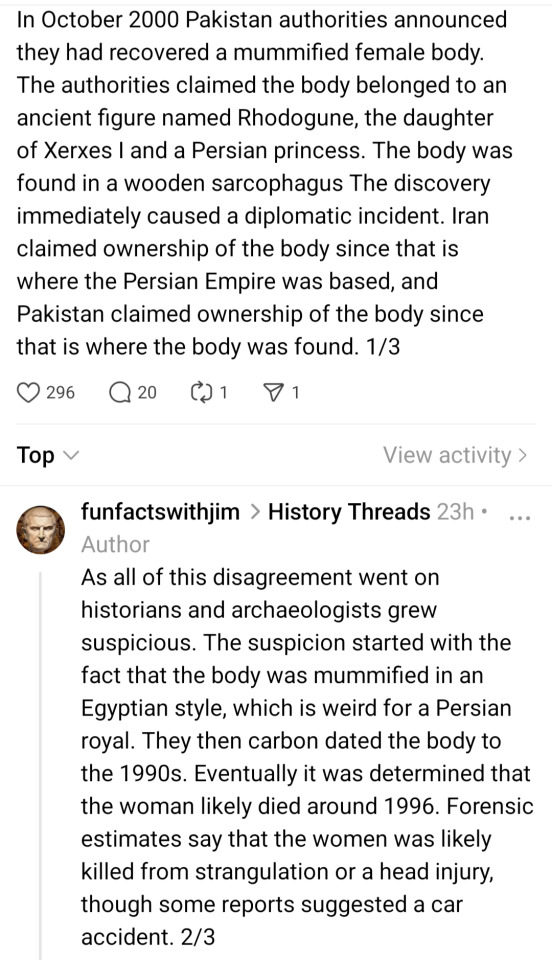
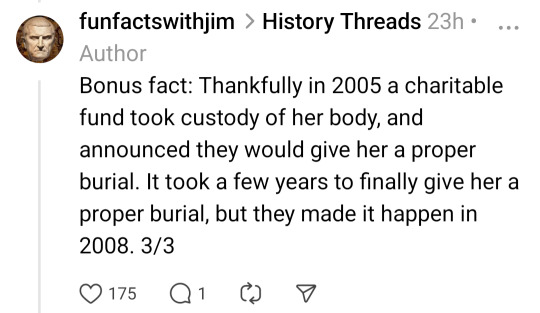
19 notes
·
View notes
Text
I'm doing my fucking forensic science assessment on OMORI. OF ALL THINGS. For context, we have to make a case study on a crime we make up with evidence and everything. It's actually a really good idea, cause I have the photo evidence, characters, outcome, motive and everything. I wish I could've added the hanging and everything, but my teacher said 'no violent crime' (boooooooooooooorrriiiiiiiiiiing) and this is already treading the line.
#silly#omori#omori sunny#omori mari#the incident#insert stairs joke#basil omori#omori fandom#i love omori#funny#school#tests#hyperfixations#forensic science#forensics#its actually pretty cool#science#high school#omori headspace#omori white space#omori blackspace
13 notes
·
View notes
Text
Forensic science funfact #1 : mummification
Tw: suicide, court medicine, discussion of dead bodies, suicide mention, explaining a ritualistic suicide method in the cultural context
After death, the body in need to mummificate needs to be kept in certain conditions: mostly very warm, away from the external factors (bugs, animals, chemicals, mold etc).
Its a long term process, usually more than 1-2 years post mortem, but there were cases where the mummification process took 2 months! -in this case, the body was found in home, with the body perfectly mummified under the covers.
There is also a process of ritual suicide of automummification called sokushinbutsu. Those people use specific diet (vaguely eating only seeds for years) and gradually commiting the suicide by actively trying to get their body into the perfect conditions for mummification.
The final step of this process is locking themselves in their final coffin where they finish the process of gradually starving themselves to death while entering the staye of deep meditation.
Another funfact: DID YOU KNOW THE REASON WHY THEY ARE SO LITTLE MUMMIES FROM THE ANCIENT TIMES IS BECAUSE WE USED TO EAT THEM IN XI CENTURY. Let me repeat, WE ATE THE MUMMIES.
Gore/sensitive photos:

Auromummified body

77-years old man found in sauna
#academia#criminology#dark academia#forensic science#university#digital artist#criminal minds#forensics#forensicscience#cw: gore#gore lover#mummification
42 notes
·
View notes
Text
sometimes I think "yeah i have my own sense of humor" and then I talk to my dad
context: my forensics teacher bought a rotisserie chicken (that he named Morty) and we are watching it decay. he flipped it over and the underside was COVERED in maggots

13 notes
·
View notes
Text

Petechiae represent multiple pinpoint areas of bleeding. They are not specific for asphyxia deaths, but are frequently present in certain types of asphyxia.
88 notes
·
View notes
Text
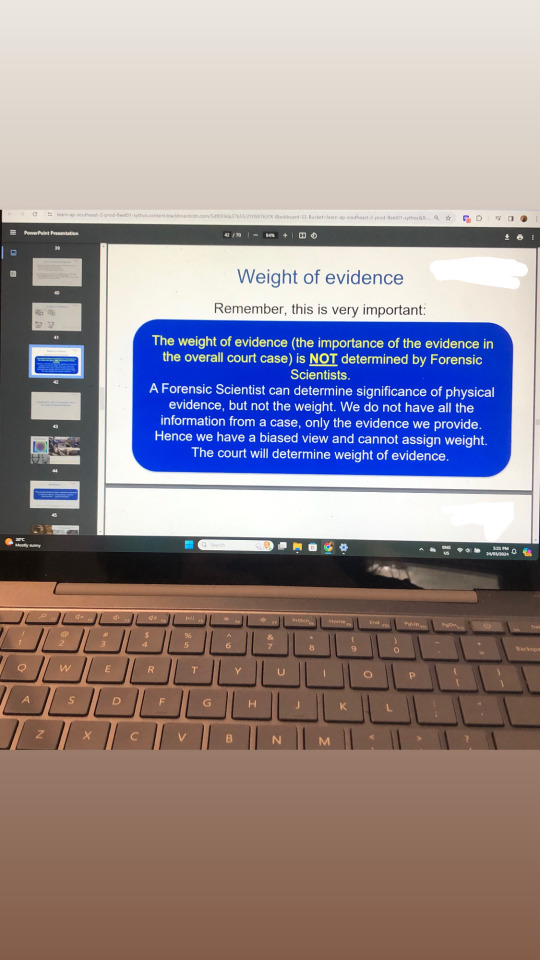

24.03.2024
.
I did a bit of forensic work and ignored the essay I have due in 3 weeks 🥲
I haven’t really been doing the best mentally so I’m taking it all one step at a time (studying enough to keep me from falling too far behind, but not enough to burn me out). Friendly reminder: there is no shame in prioritising your mental health!
And yes, my pen is shaped like a syringe (it used to have red liquid inside but it dried up :/)
#study#study aesthetic#study blog#study motivation#studyblr#studyspo#forensic notes#forensic science
75 notes
·
View notes
Text
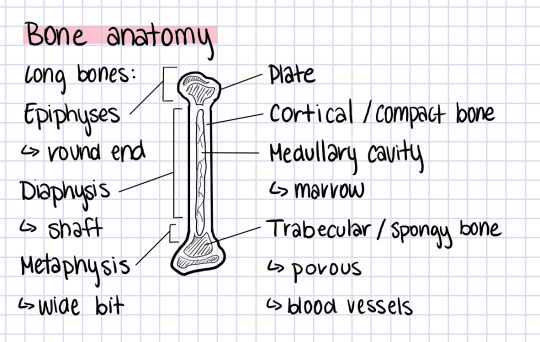
#do u like my bone drawing#tags#stem#stemblr#studyblr#study notes#criminalistics#forensic science#forensics#biology#anatomy#human anatomy#forensic anthropology#physical anthropology#science#medicine#science side of tumblr#women in stem
12 notes
·
View notes
Text

Best criminal minds character❤️❤️❤️
67 notes
·
View notes
